Breastfeeding Report: Infant Nutrition, Health and Maternal Impact
VerifiedAdded on 2021/11/17
|5
|692
|80
Report
AI Summary
This report provides a detailed overview of breastfeeding, starting from the initial stages with colostrum and progressing through transition and mature milk. It emphasizes the nutritional benefits of breast milk for infants, highlighting its composition and the presence of antibodies that protect against diseases. The report also discusses the advantages of breastfeeding for both infants and mothers, referencing studies and guidelines. It examines the impact of breastfeeding on maternal weight and overall health, supported by research findings. The report concludes by summarizing the key advantages of breastfeeding, including the provision of essential nutrients and immune support for infants.
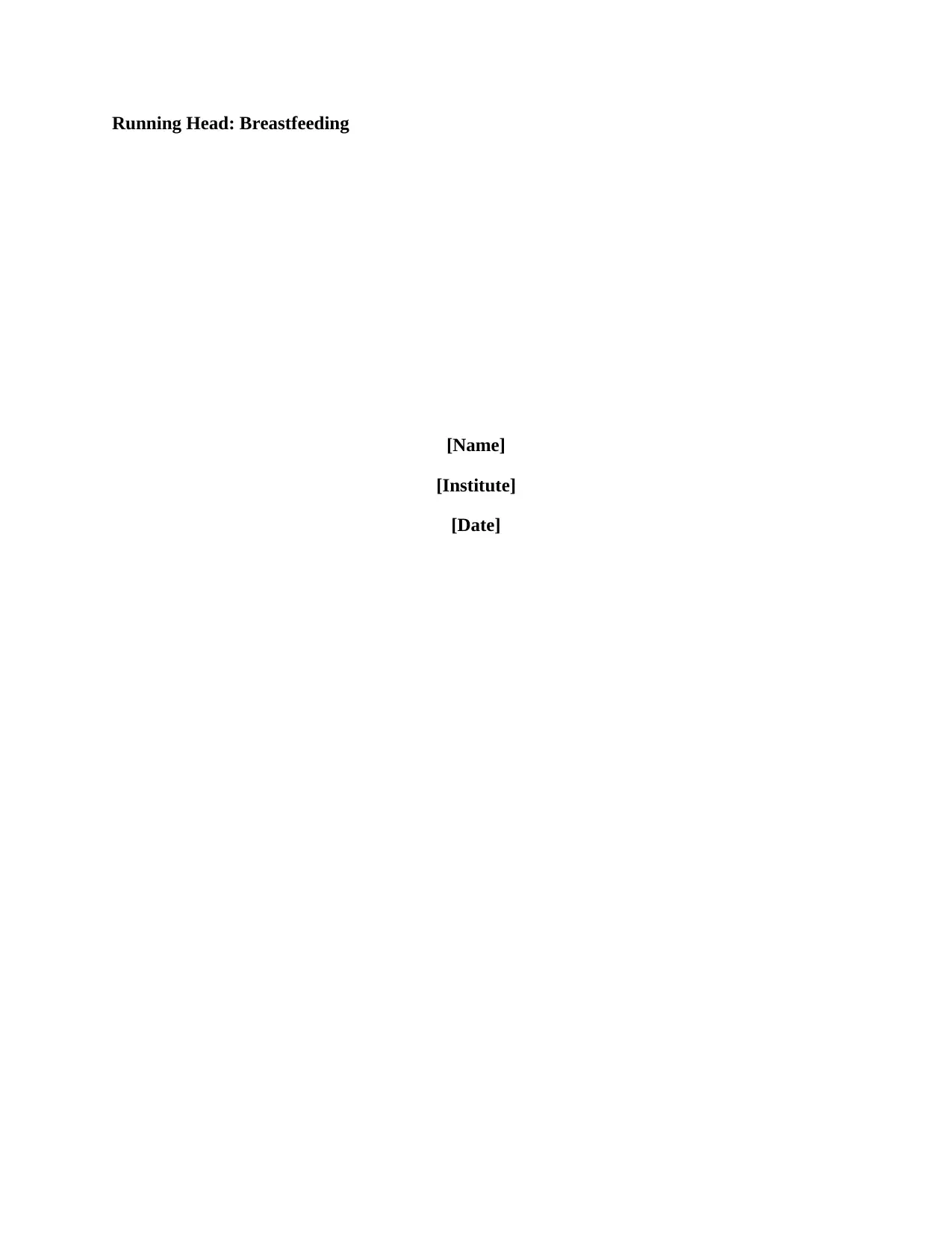
Running Head: Breastfeeding
[Name]
[Institute]
[Date]
[Name]
[Institute]
[Date]
Paraphrase This Document
Need a fresh take? Get an instant paraphrase of this document with our AI Paraphraser
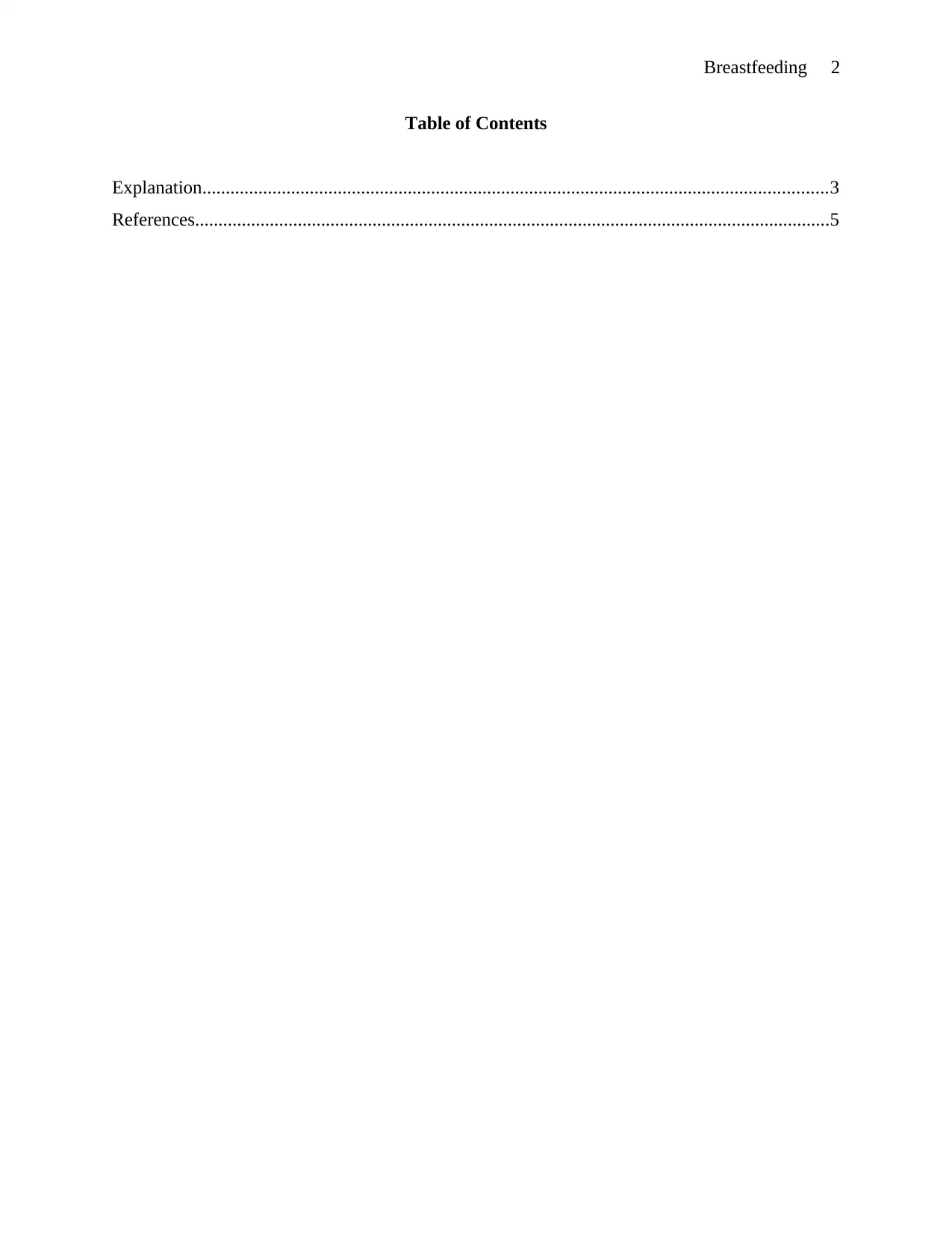
Breastfeeding 2
Table of Contents
Explanation......................................................................................................................................3
References........................................................................................................................................5
Table of Contents
Explanation......................................................................................................................................3
References........................................................................................................................................5
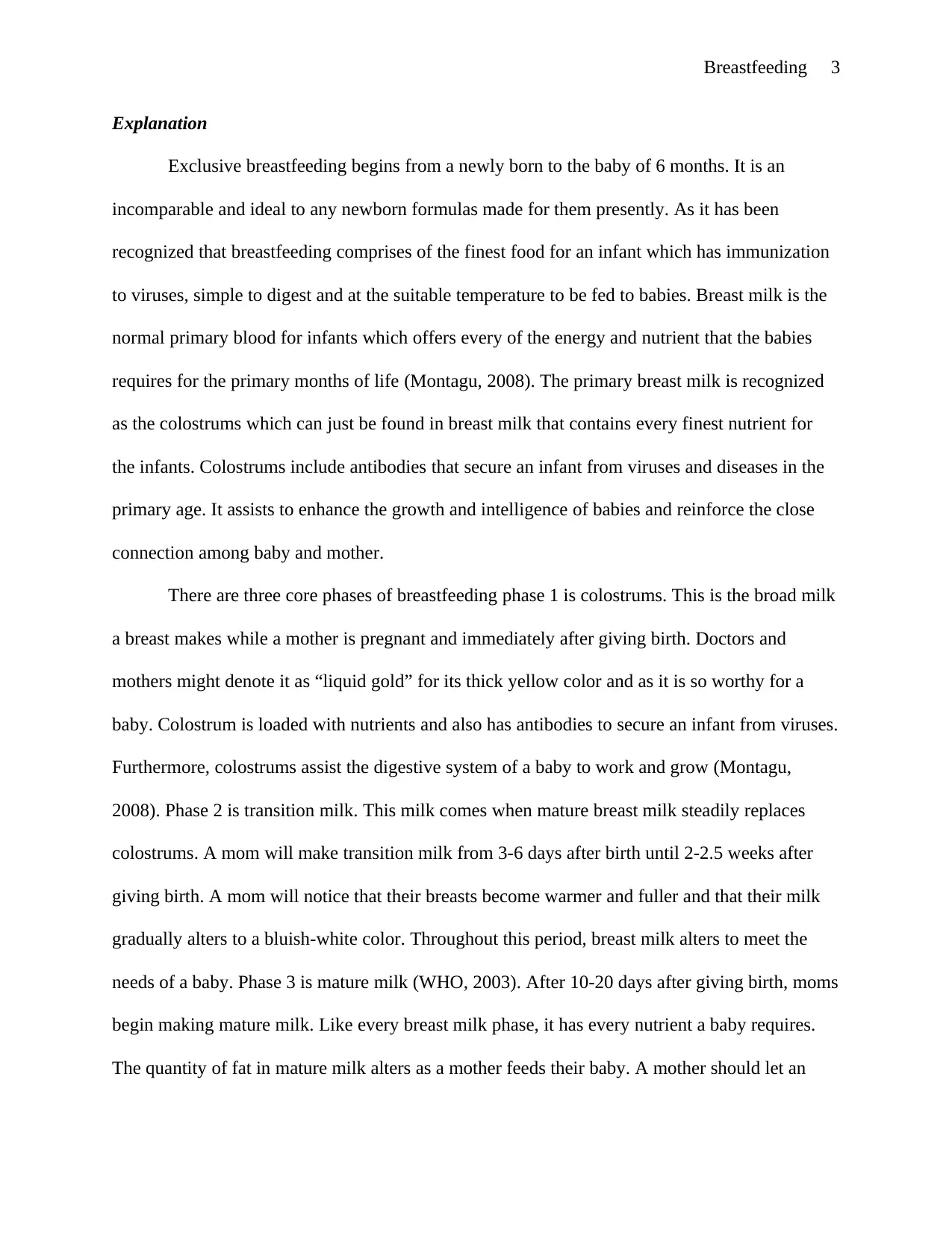
Breastfeeding 3
Explanation
Exclusive breastfeeding begins from a newly born to the baby of 6 months. It is an
incomparable and ideal to any newborn formulas made for them presently. As it has been
recognized that breastfeeding comprises of the finest food for an infant which has immunization
to viruses, simple to digest and at the suitable temperature to be fed to babies. Breast milk is the
normal primary blood for infants which offers every of the energy and nutrient that the babies
requires for the primary months of life (Montagu, 2008). The primary breast milk is recognized
as the colostrums which can just be found in breast milk that contains every finest nutrient for
the infants. Colostrums include antibodies that secure an infant from viruses and diseases in the
primary age. It assists to enhance the growth and intelligence of babies and reinforce the close
connection among baby and mother.
There are three core phases of breastfeeding phase 1 is colostrums. This is the broad milk
a breast makes while a mother is pregnant and immediately after giving birth. Doctors and
mothers might denote it as “liquid gold” for its thick yellow color and as it is so worthy for a
baby. Colostrum is loaded with nutrients and also has antibodies to secure an infant from viruses.
Furthermore, colostrums assist the digestive system of a baby to work and grow (Montagu,
2008). Phase 2 is transition milk. This milk comes when mature breast milk steadily replaces
colostrums. A mom will make transition milk from 3-6 days after birth until 2-2.5 weeks after
giving birth. A mom will notice that their breasts become warmer and fuller and that their milk
gradually alters to a bluish-white color. Throughout this period, breast milk alters to meet the
needs of a baby. Phase 3 is mature milk (WHO, 2003). After 10-20 days after giving birth, moms
begin making mature milk. Like every breast milk phase, it has every nutrient a baby requires.
The quantity of fat in mature milk alters as a mother feeds their baby. A mother should let an
Explanation
Exclusive breastfeeding begins from a newly born to the baby of 6 months. It is an
incomparable and ideal to any newborn formulas made for them presently. As it has been
recognized that breastfeeding comprises of the finest food for an infant which has immunization
to viruses, simple to digest and at the suitable temperature to be fed to babies. Breast milk is the
normal primary blood for infants which offers every of the energy and nutrient that the babies
requires for the primary months of life (Montagu, 2008). The primary breast milk is recognized
as the colostrums which can just be found in breast milk that contains every finest nutrient for
the infants. Colostrums include antibodies that secure an infant from viruses and diseases in the
primary age. It assists to enhance the growth and intelligence of babies and reinforce the close
connection among baby and mother.
There are three core phases of breastfeeding phase 1 is colostrums. This is the broad milk
a breast makes while a mother is pregnant and immediately after giving birth. Doctors and
mothers might denote it as “liquid gold” for its thick yellow color and as it is so worthy for a
baby. Colostrum is loaded with nutrients and also has antibodies to secure an infant from viruses.
Furthermore, colostrums assist the digestive system of a baby to work and grow (Montagu,
2008). Phase 2 is transition milk. This milk comes when mature breast milk steadily replaces
colostrums. A mom will make transition milk from 3-6 days after birth until 2-2.5 weeks after
giving birth. A mom will notice that their breasts become warmer and fuller and that their milk
gradually alters to a bluish-white color. Throughout this period, breast milk alters to meet the
needs of a baby. Phase 3 is mature milk (WHO, 2003). After 10-20 days after giving birth, moms
begin making mature milk. Like every breast milk phase, it has every nutrient a baby requires.
The quantity of fat in mature milk alters as a mother feeds their baby. A mother should let an
⊘ This is a preview!⊘
Do you want full access?
Subscribe today to unlock all pages.

Trusted by 1+ million students worldwide
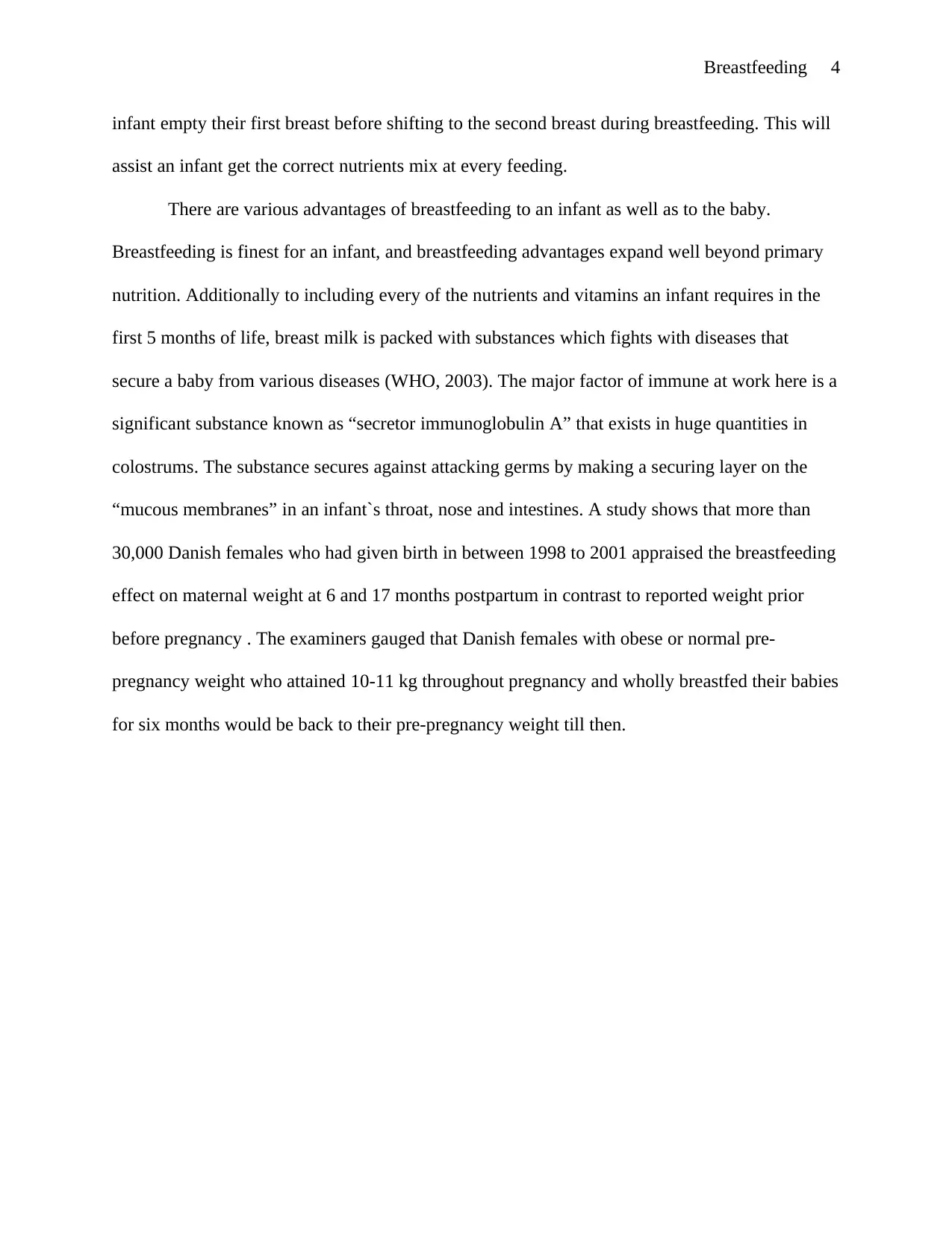
Breastfeeding 4
infant empty their first breast before shifting to the second breast during breastfeeding. This will
assist an infant get the correct nutrients mix at every feeding.
There are various advantages of breastfeeding to an infant as well as to the baby.
Breastfeeding is finest for an infant, and breastfeeding advantages expand well beyond primary
nutrition. Additionally to including every of the nutrients and vitamins an infant requires in the
first 5 months of life, breast milk is packed with substances which fights with diseases that
secure a baby from various diseases (WHO, 2003). The major factor of immune at work here is a
significant substance known as “secretor immunoglobulin A” that exists in huge quantities in
colostrums. The substance secures against attacking germs by making a securing layer on the
“mucous membranes” in an infant`s throat, nose and intestines. A study shows that more than
30,000 Danish females who had given birth in between 1998 to 2001 appraised the breastfeeding
effect on maternal weight at 6 and 17 months postpartum in contrast to reported weight prior
before pregnancy . The examiners gauged that Danish females with obese or normal pre-
pregnancy weight who attained 10-11 kg throughout pregnancy and wholly breastfed their babies
for six months would be back to their pre-pregnancy weight till then.
infant empty their first breast before shifting to the second breast during breastfeeding. This will
assist an infant get the correct nutrients mix at every feeding.
There are various advantages of breastfeeding to an infant as well as to the baby.
Breastfeeding is finest for an infant, and breastfeeding advantages expand well beyond primary
nutrition. Additionally to including every of the nutrients and vitamins an infant requires in the
first 5 months of life, breast milk is packed with substances which fights with diseases that
secure a baby from various diseases (WHO, 2003). The major factor of immune at work here is a
significant substance known as “secretor immunoglobulin A” that exists in huge quantities in
colostrums. The substance secures against attacking germs by making a securing layer on the
“mucous membranes” in an infant`s throat, nose and intestines. A study shows that more than
30,000 Danish females who had given birth in between 1998 to 2001 appraised the breastfeeding
effect on maternal weight at 6 and 17 months postpartum in contrast to reported weight prior
before pregnancy . The examiners gauged that Danish females with obese or normal pre-
pregnancy weight who attained 10-11 kg throughout pregnancy and wholly breastfed their babies
for six months would be back to their pre-pregnancy weight till then.
Paraphrase This Document
Need a fresh take? Get an instant paraphrase of this document with our AI Paraphraser
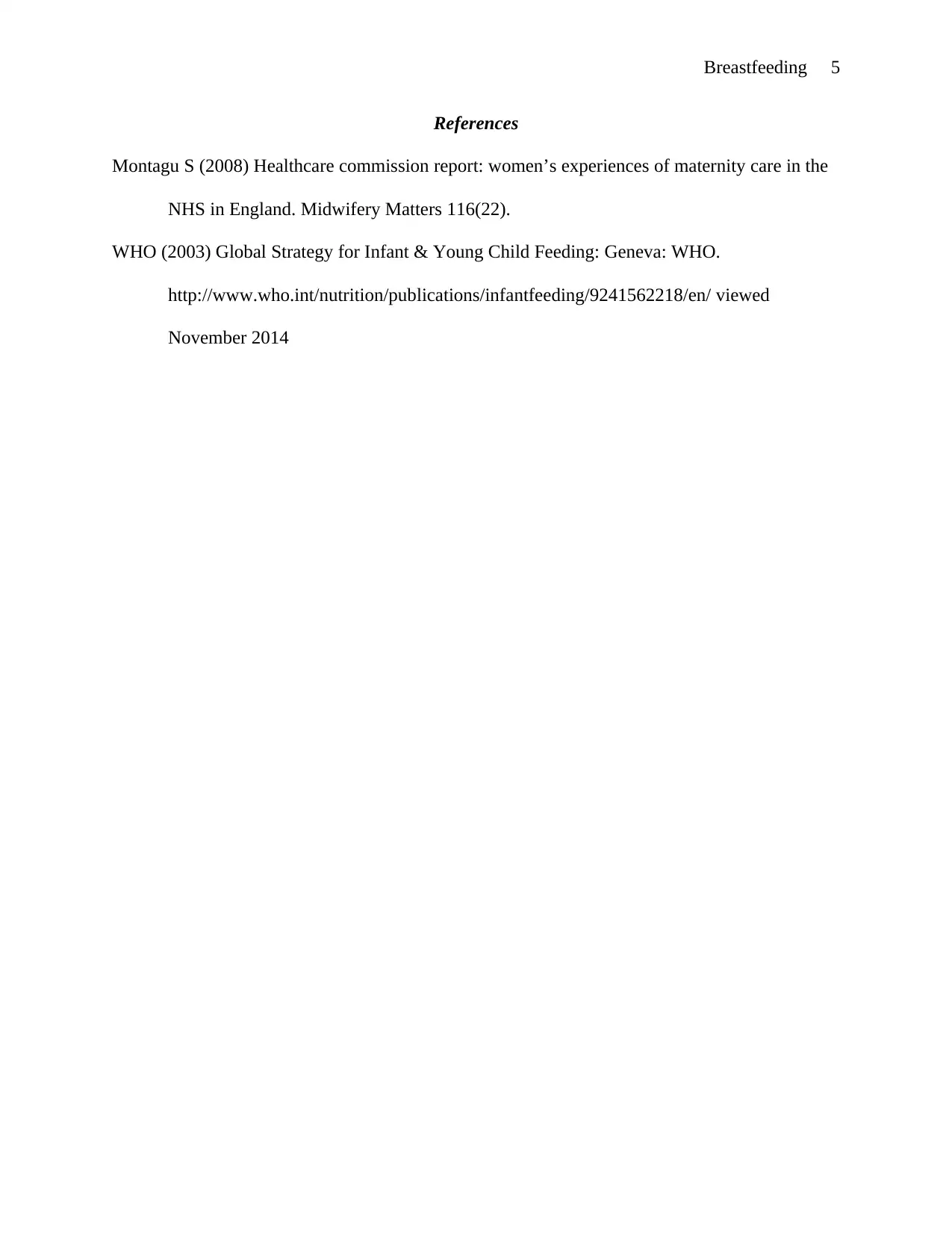
Breastfeeding 5
References
Montagu S (2008) Healthcare commission report: women’s experiences of maternity care in the
NHS in England. Midwifery Matters 116(22).
WHO (2003) Global Strategy for Infant & Young Child Feeding: Geneva: WHO.
http://www.who.int/nutrition/publications/infantfeeding/9241562218/en/ viewed
November 2014
References
Montagu S (2008) Healthcare commission report: women’s experiences of maternity care in the
NHS in England. Midwifery Matters 116(22).
WHO (2003) Global Strategy for Infant & Young Child Feeding: Geneva: WHO.
http://www.who.int/nutrition/publications/infantfeeding/9241562218/en/ viewed
November 2014
1 out of 5
Related Documents
Your All-in-One AI-Powered Toolkit for Academic Success.
+13062052269
info@desklib.com
Available 24*7 on WhatsApp / Email
![[object Object]](/_next/static/media/star-bottom.7253800d.svg)
Unlock your academic potential
Copyright © 2020–2025 A2Z Services. All Rights Reserved. Developed and managed by ZUCOL.




